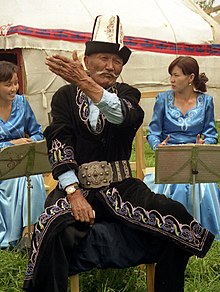
Back تراث شفهي Arabic মৌখিক পৰম্পৰা Assamese Şifahi ənənə Azerbaijani মৌখিক প্রথা Bengali/Bangla Transmissió oral Catalan Lidová slovesnost Czech Mundtlig overlevering Danish Mündliche Überlieferung German Oral tradition English Parola tradicio Esperanto

Ffurf ar gyfathrebu gan fodau dynol sy'n trosglwyddo gwybodaeth, celf, llên, syniadau, a deunydd diwylliannol arall o oes i oes yw traddodiad llafar.[1][2] Trosglwyddir yr hynny ar lafar, drwy gyfrwng sgwrs neu anerchiad neu ar gân, gan gynnwys straeon gwerin, baledi, llafarganau, a phenillion. Trwy draddodiad llafar mae cymdeithas yn trosglwyddo llên lafar, hanes llafar, cyfraith lafar, a ffurfiau eraill ar wybodaeth o'r hen genhedlaeth i'r genhedlaeth iau heb yr angen am system ysgrifennu. Hwn felly oedd y prif fodd o drosglwyddo gwybodaeth mewn cymdeithasau cynlythrennog, ac yn agwedd bwysig hefyd mewn cymdeithasau llythrennog yn gyfochrog â llên ysgrifenedig. Mae crefyddau'r dwyrain megis Bwdhaeth, Hindŵaeth, a Jainiaeth, er enghraifft, wedi defnyddio traddodiadau llafar ar y cyd â systemau ysgrifennu i drosglwyddo'r ysgrythur ganonaidd, gwybodaeth seciwlar megis Sushruta Samhita, emynau, a mythau o oes i oes.[3][4]
- ↑ Vansina, Jan: Oral Tradition as History (1985), reported statements from present generation which "specifies that the message must be oral statements spoken, sung or called out on musical instruments only"; "There must be transmission by word of mouth over at least a generation". He points out, "Our definition is a working definition for the use of historians. Sociologists, linguists or scholars of the verbal arts propose their own, which in, e.g., sociology, stresses common knowledge. In linguistics, features that distinguish the language from common dialogue (linguists), and in the verbal arts features of form and content that define art (folklorists)."
- ↑ Ki-Zerbo, Joseph: "Methodology and African Prehistory", 1990, UNESCO International Scientific Committee for the Drafting of a General History of Africa; James Currey Publishers, ISBN 0-85255-091-X, 9780852550915; see Ch. 7; "Oral tradition and its methodology" at pages 54-61; at page 54: "Oral tradition may be defined as being a testimony transmitted verbally from one generation to another. Its special characteristics are that it is verbal and the manner in which it is transmitted."
- ↑ Jack Goody (1987). The Interface Between the Written and the Oral. Cambridge University Press. tt. 110–121. ISBN 978-0-521-33794-6.
- ↑ Donald S. Lopez Jr. (1995). "Authority and Orality in the Mahāyāna". Numen (Brill Academic) 42 (1): 21–47. JSTOR 3270278.
© MMXXIII Rich X Search. We shall prevail. All rights reserved. Rich X Search